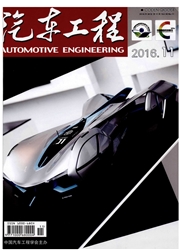

 中文摘要:
中文摘要:
为实现电动轮汽车的差速功能并评估控制系统的影响因素,以两侧驱动轮滑移率一致为目标,提出了基于转矩控制的差速控制策略,利用BP神经网络方法,设计了电子差速控制系统.运用汽车动力学理论,建立了9自由度的前轮转向后轮驱动电动轮汽车动力学模型,以进行理论分析和仿真.通过对模型的合理简化和线性化,得到了控制系统线性状态方程和车轮滑移率的解析表达式.根据理论分析,影响电子差速控制性能的参数主要是整车质量和质心位置.但仿真结果表明,整车质量对控制效果影响不大,质心位置对控制性能影响相对较大,但整体上仍然较小.所提出的电子差速控制策略达到预期目标,控制系统对系统参数变化具有较好的鲁棒性.
 英文摘要:
英文摘要:
To achieve electronic differential function and to estimate the affecting factors of its control sys- tem for an in-wheel-motor drive electric vehicle, and with equalizing the slip rats of both drive wheels as objective, a differential control strategy is proposed based on torque control scheme and an electronic differential control system is designed by using BP neural network method. Based on vehicle dynamics theory, a 9 DOF dynamic model for an in-wheel-motor drive electric vehicle with front-wheel-steering and rear-wheel-drive is built to conduct theoretical a- nalysis and simulation. Through the reasonable simplification and linearization of model, the linear state equations of control system and the analytical expression of wheel slip rate are derived. According to theoretical analysis, the key parameters affecting the electronic differential control performances are vehicle mass and the position of mass center, while the stimulation results show that the effect of the position of mass center on control system performance, though still relatively small, is far more than that of vehicle mass. The electronic differential control strategy proposed a- chieves the expected objective and the control system has sound robustness to system parameter variation.
 同期刊论文项目
同期刊论文项目
 同项目期刊论文
同项目期刊论文
 期刊信息
期刊信息
